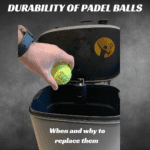This post may contain affiliate links.

The number of padel courts is growing massively and the sport is embraced by many people. However, noise is a downside, especially to neighbors that live close to a padel court. Therefore I decided to find out how much noise is produced during padel and how it can be reduced.
On average padel produces between 66-68 decibels of noise levels. A reduction of noise emission values can be achieved by sound-absorbing constructions and environmental planning.
To substantiate this claim, I will uncover each aspect in greater detail in the remainder of this article. You will be able to put these values into perspective and compare it with other practical examples.
Interested in a particular aspect of the topic? Just navigate directly using these buttons:
Noise Levels of Padel Courts
On average padel courts produce 66-68 decibels of noise levels on outdoor courts, while this number is usually higher for indoor courts. While noise levels are higher for indoor courts, noise nuisance experienced by neighbors is lower.
During peak hours the noise level can reach 68 – 70 dB for a padel club containing seven indoor courts and one outdoor court. They measured these values from across the street and there were no sound protection walls. But how are these values actually measured?
for a padel club containing seven indoor courts and one outdoor court. They measured these values from across the street and there were no sound protection walls. But how are these values actually measured?
Noise levels are known as noise emission values that are denominated in decibels (dB). Nowadays you can use your phone to measure noise emission values, albeit less accurate. Therefore professionals use dedicated devices that are made for this exact purpose and leading to skewed values and conclusions. Noise measurement systems usually include recording microphones with a pre-amplifier, an amplifier, and software to process the data.
Since I don’t have this dedicated measurement system, I went for the feasible (and less accurate) option: dB meter app.

Measurements were taken over the course of a 1.5-hour session during peak hours (fully occupied). The indoor facility hosts 5 indoor courts and the noise levels were measured at the center of the facility to ensure more accurate results.

Note that the maximum dB levels (83.6 dB) are much higher than the average 66.6 dB, due to the cheering of the players. The average noise level of 66.6 dB is in line with the average range of 65-68 dB. Nevertheless, these results need to be taken with a grain of salt, due to the accuracy of the app, compared to professional equipment.
Is Padel Too Noisy?
Padel can produce noise levels that exceed the allowed levels. However, the nuisance as a result of padel is dependent on multiple factors, such as duration, time, location, and blocking objects.
According to the guidelines of the Dutch Noise Nuisance Foundation , the maximum noise levels are dependent on the time of day. The maximum noise level is 65 dB (7 am – 7 pm) and 60 dB (7 pm – 11 pm). The average allowed noise level over a prolonged period of time is 50 dB during the day (from 7 am to 7 pm) and 45 dB at night (from 7 pm – 11 pm).
, the maximum noise levels are dependent on the time of day. The maximum noise level is 65 dB (7 am – 7 pm) and 60 dB (7 pm – 11 pm). The average allowed noise level over a prolonged period of time is 50 dB during the day (from 7 am to 7 pm) and 45 dB at night (from 7 pm – 11 pm).
Another determining factor of the nuisance is the distance between the padel facility and surrounding buildings. Unfortunately, there is no padel-specific guideline for the minimum distance to avoid nuisance. For all intents and purposes, we’ll look at the sport most closely related to padel, you might have guessed it, tennis. The minimum distance between a residential home and an outdoor tennis court/facility needs to be 50 meters. For an indoor sports complex (such as indoor tennis or squash court), the minimum distance is also 50 meters.
While considering the impact of any transgression of the allowed guidelines, the authorities will consider who will actually experience the nuisance. Padel facilities that are located in a remote part of a city are causing less nuisance in general compared to a padel court in a neighborhood. The allowed levels will be adjusted based on that situation. Generally speaking, residential areas require more protection than neighbors from the local government/municipality, especially during the definition of a zoning plan.
A cautionary tale for anyone thinking that these guidelines don’t affect reality:
In 2019 the French court decided to close a padel facility after complaints from the neighborhood due to noise nuisance. The renowned tennis facility which had padel courts since 2002, was not allowed to have noise levels that exceeded more than 5 dB compared to the ambient noise levels. However, the registered noise levels were exceeding the background noise by 12 dB.
after complaints from the neighborhood due to noise nuisance. The renowned tennis facility which had padel courts since 2002, was not allowed to have noise levels that exceeded more than 5 dB compared to the ambient noise levels. However, the registered noise levels were exceeding the background noise by 12 dB.
Padel Noise Levels: Put it into perspective
In general, padel produces higher noise levels than tennis and other sports played on artificial grass.
The World Health Organization (WHO) recommends the yearly average noise level for leisure to be maximum of 70 dB. While this is of course broadly defined advice, scientific research
recommends the yearly average noise level for leisure to be maximum of 70 dB. While this is of course broadly defined advice, scientific research has shown that prolonged exposure to noise levels above 70 dB may damage your hearing.
has shown that prolonged exposure to noise levels above 70 dB may damage your hearing.
According to scientific research,  the maximum noise level in tennis is around 58 dB. During this experiment, the subjects rated the level of annoyance for each tennis shot. The results indicated that people rate the experienced annoyance of noise in accordance with the noise level (in dB). As expected, loud tennis shots (max 58 dB) were perceived as more annoying than soft tennis shots (max 52 dB). However, the perceived annoyance of those subjects was in direct proportion to the actual noise level.
the maximum noise level in tennis is around 58 dB. During this experiment, the subjects rated the level of annoyance for each tennis shot. The results indicated that people rate the experienced annoyance of noise in accordance with the noise level (in dB). As expected, loud tennis shots (max 58 dB) were perceived as more annoying than soft tennis shots (max 52 dB). However, the perceived annoyance of those subjects was in direct proportion to the actual noise level.
Padel generates a noise 10 dB higher than that of tennis, according to a study by the Dutch Noise Nuisance Foundation . These results are in line with my own findings on the noise level in padel (66 – 68 dB) and the comparison against noise levels for tennis (52 – 58 dB). Now that we now padel produces higher level than tennis, what about other sports?
. These results are in line with my own findings on the noise level in padel (66 – 68 dB) and the comparison against noise levels for tennis (52 – 58 dB). Now that we now padel produces higher level than tennis, what about other sports?
Another study looked at the noise emission values for field hockey. The ambient values were around 45 dB, while the values for hockey were 51 dB on average. This 6 dB difference influences the perception of the noise nuisance, regardless of the actual noise level.
The typical noise level for a game that is played on artificial grass is 58 dB. Noise values in this study were measured 10 meters from the sideline at half of the field. Based on these values, the noise levels are expected to range between 42-44 dB for the nearest residential homes. Needless to say, the levels depend greatly on the specifics of the location.
were measured 10 meters from the sideline at half of the field. Based on these values, the noise levels are expected to range between 42-44 dB for the nearest residential homes. Needless to say, the levels depend greatly on the specifics of the location.
Nevertheless, these numbers make it difficult to relate to everyday noise values. Therefore let’s compare these values in the overview below before we focus our attention on the reduction of noise levels.

How To Reduce The Noise For Padel Courts?
Sound-absorbing constructions and environmental planning can reduce noise levels and/or noise nuisance.
Before discussing the actual solutions, it is worth elaborating on the objective for noise reduction for indoor and outdoor courts. Noise can be blocked or absorbed depending on the objective. Indoor sounds need to be absorbed since blocking the noise would hardly reduce the noise levels. Absorbing the sound would reduce the noise nuisance for players and staff of the facility.
For outdoor courts, sounds can either be absorbed or blocked. The main concern for outdoor courts is the noise nuisance experienced by people outside of the facility. As discussed earlier, the main concern is residential homes.
Sound-absorbing constructions
Since padel is played in a court surrounded by glass, it is deemed to be an acoustic nightmare. For indoor facilities, acoustic panels can absorb some of the sounds and make the facility sound better.
But, don’t take my word for it. Padel Zenter in Stockholm (owned by football player Zlatan Ibrahimovic), uses acoustic screens to make the facility more enjoyable. These screens are printed to blend in with the rest of the facility’s design.
(owned by football player Zlatan Ibrahimovic), uses acoustic screens to make the facility more enjoyable. These screens are printed to blend in with the rest of the facility’s design.
Acoustic screens or walls generally consist of a steel frame filled with sound-absorbing materials such as glass wool or rock wool. The quality of sound-absorbing materials increases along with the thickness of each layer as well as the number of layers. Products that are made of highly compressed materials absorb sounds better while reducing the space these screens/walls occupy.
Another option for indoor courts would be to use another acoustic trick, as implemented in the picture below. This would involve placing sound-absorbing curtains that run around the courts to absorb noise that would otherwise hit the (less absorbing) walls of the indoor facility.

Sounding walls can be constructed along this demarcation aka build your own padel fortress.
With the exploding growth came also the growth in noise nuisance and complaints. As a result of the pressure, regional governmental bodies are required to look into regulatory requirements to ensure that padel courts can co-exist with the neighborhood. The construction of new courts needs to adhere to stricter noise emission levels, making it harder to construct a padel court.
One common prerequisite for the approval of a padel construction plan is to mark the designated area. Sounding walls can be constructed along this demarcation aka build your own padel fortress. I know, it sounds more fun than it is.
However sound walls do come in many shapes and forms, making it easier to blend into the overall landscape. For example, industrial areas might use aluminum or steel walls, whereas, in more natural environments, wood would be more aesthetic.
Environmental planning
Ideally, noise reduction is considered before the construction of a padel court or facility. Due to the growing interest in the sport, many club owners and investors focused their efforts on constructing these courts as quickly as possible. Nevertheless, there is much benefit in environmental planning before building to reduce complaints.
First of all, construct the facility in such a way that the courts are as far away from the neighbors as possible (especially in a residential neighborhood).
Another important solution that is similar to the demarcation using acoustic walls. The creation of a wall from the excess materials or dirt while creating the facility seems to be an efficient use of materials. Ideally, this demarcation would run all around the facility to encapsulate the sound as much as possible.
Measure The Effectiveness Of A Noise Reducing Solution
A Sound Transmission Class rating denominates the reduction of noise (in decibels) and can be used to evaluate the effectiveness of the solution.
While noise is measured in decibels (dB), the reduction of noise (in dB) is denominated in STC (Sound Transmission Class) rating. STC ratings are calculated as a weighted average of Sound Transmission Loss values over 16 frequencies. A typical glass window has an STC rating of around 26. This means that it would reduce the noise by 26 dB. Insulated and acoustic walls reduce noise by about 36 dB and a masonry wall (10 inches) reduces noise by 50 dB, which would numb much of the non-extreme everyday sounds.
A typical glass window has an STC rating of around 26. This means that it would reduce the noise by 26 dB. Insulated and acoustic walls reduce noise by about 36 dB and a masonry wall (10 inches) reduces noise by 50 dB, which would numb much of the non-extreme everyday sounds.
| Material | Noise Reduction (STC Rating) |
|---|---|
| Glass window | 26 dB |
| Insulated wall | 36 dB |
| Masonry wall (10′) | 50 dB |
The caveat here is that noises below 125 Hz (such as bass) cannot be reduced easily by sound-absorbing materials. In this case, higher STC ratings do not necessarily mean lower noise levels.
by sound-absorbing materials. In this case, higher STC ratings do not necessarily mean lower noise levels.
Final thought experiment
Why not cover the glass walls with soundproofing materials, you might wonder? Well, besides the glass walls, the rest of the court is open. I mean, you still have other open areas such as the fence, there is no door and no direct ceiling. If only 5% of the court would be open, it would reduce the noise transmission by 13 dB. Even if you would cover the glass walls and fence with soundproof material (on the outside), the open area would still be so big that the noise reduction would in that scenario be virtually non-existent. If there would be a direct ceiling that fully encapsulates the court, you would realize a relatively small reduction in noise. And of course, you would make it into another game, since you can’t properly lob anymore. Next to that, it will lose the ability for spectators since the court would be covered up. So let’s kill this thought.







